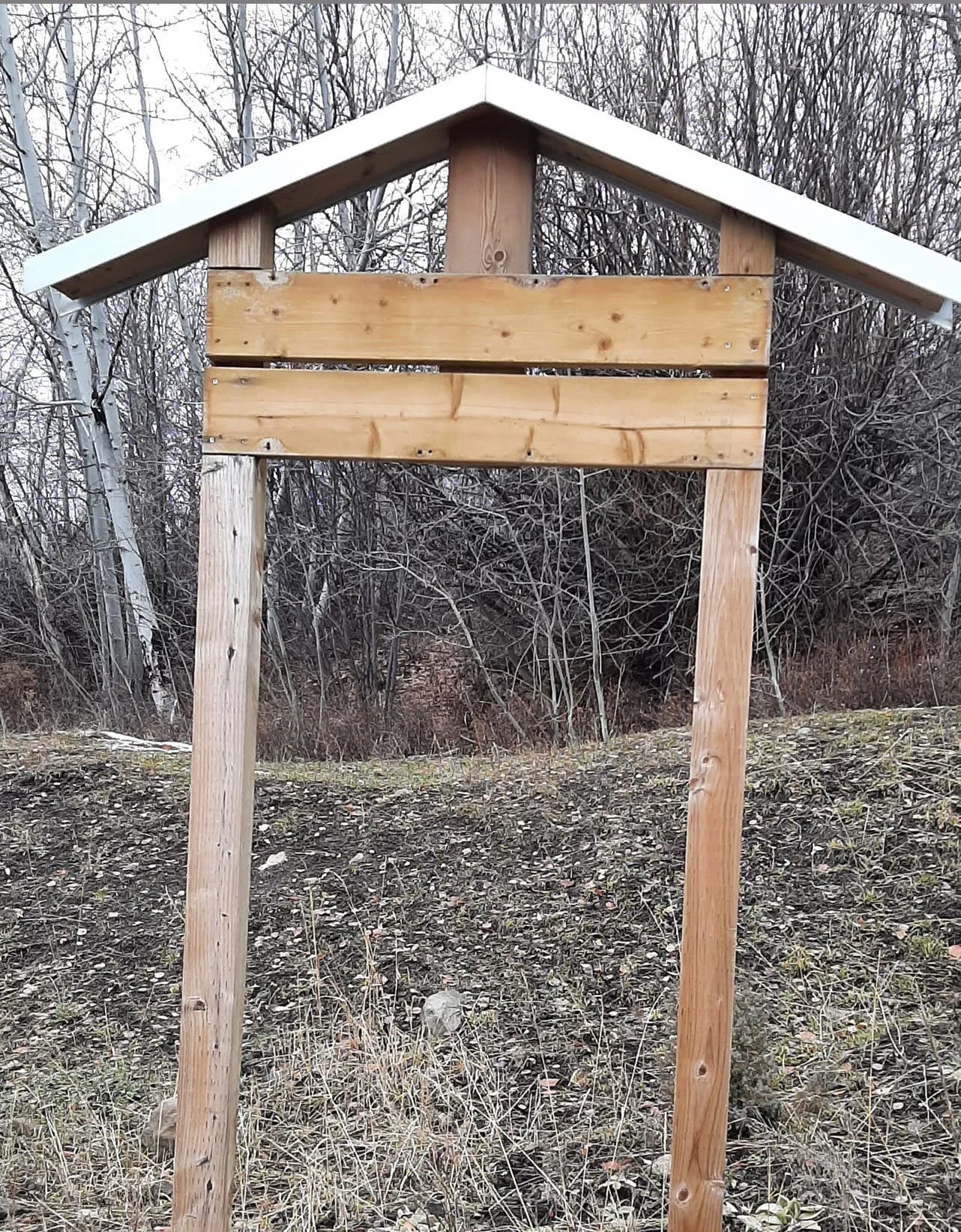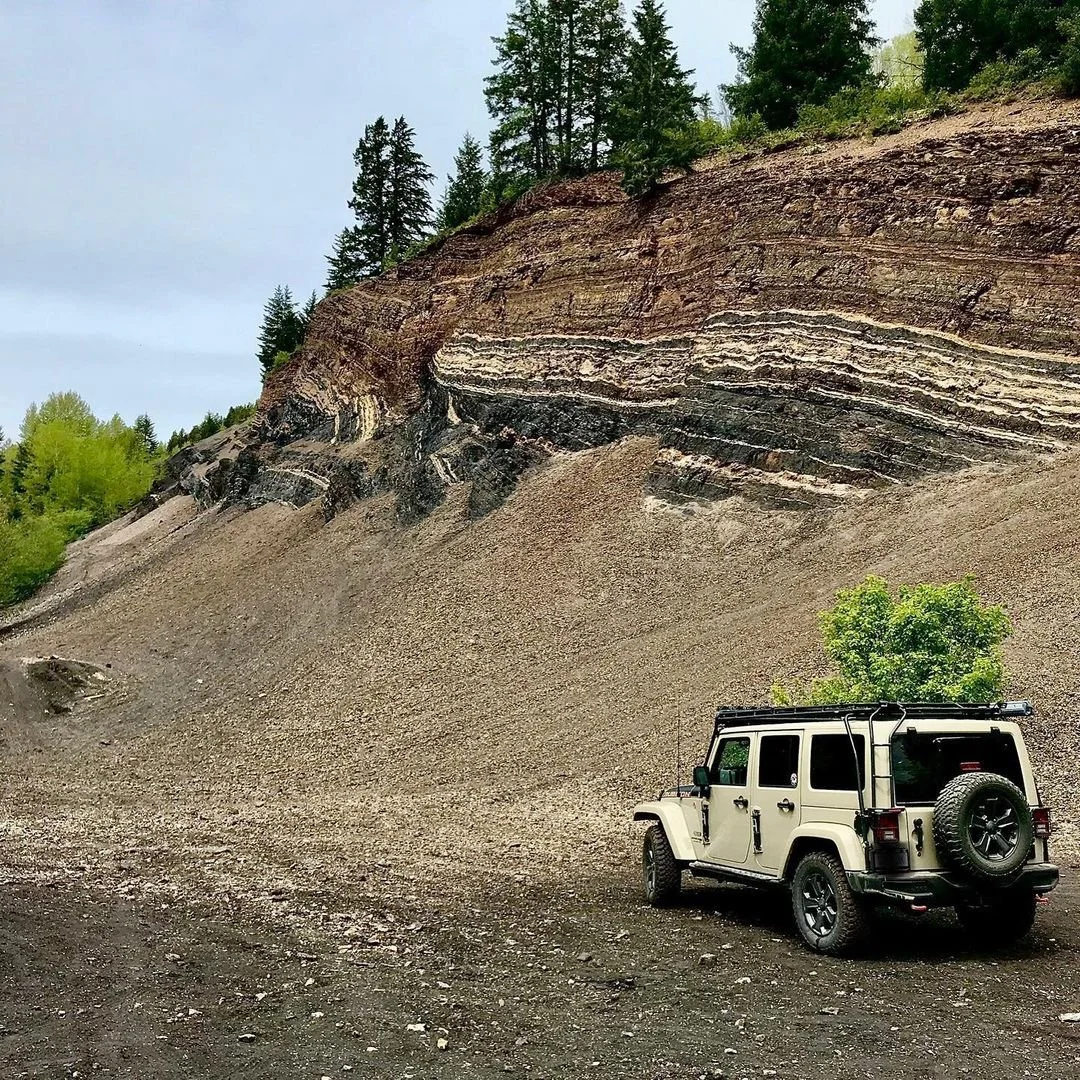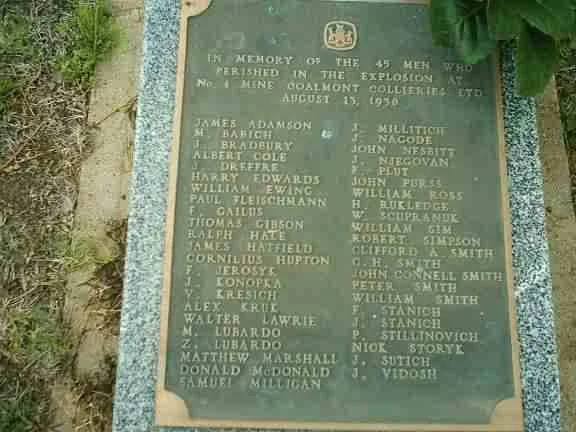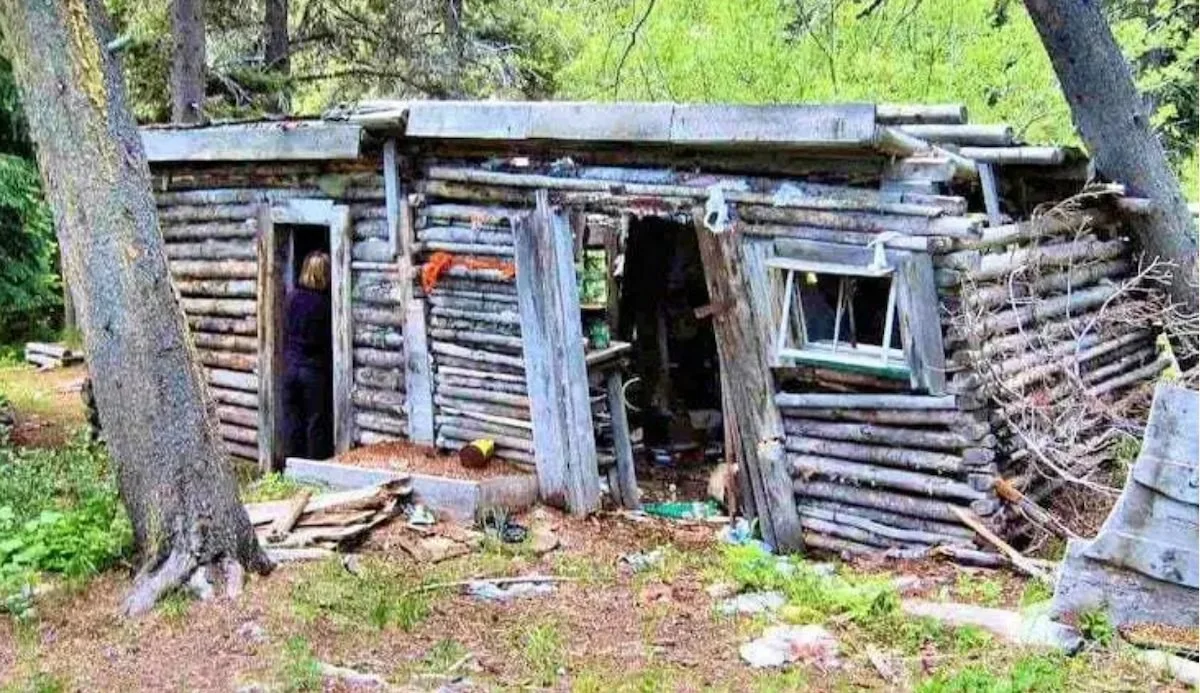Black Wednesday Spelled Death For the Coal Dust Twins
Way back in the Dark Ages, 1977 to be exact, I completed a three-week-long blitz of dozens of southern mainland B.C. ghost towns while researching a never completed series of books on the subject.
Among the sites I visited in the Similkameen District was Coalmont, 11 miles (18km) northwest of Princeton, and mountainside Blakeburn, located southwest of the confluence of Granite Creek and the Tulameen River.
Coalmont, which was the railhead connection to the Kettle Valley Railway for the Blakeburn Mine, still has 80 permanent and 20 seasonal residents.
Not so Blakeburn. But for the collapsing remains of some log cabins and wood-framed houses, a tramway tower, concrete ruins and scarred landscape, there’s little to show that this was once a thriving community of 500 souls.
Nothing in the way of a memorial to the 45 men of the Blakeburn Mine who, on Black Wednesday, Aug. 1, 1930, were victims of an horrific explosion and who are buried in a collective grave in the Princeton Cemetery.
This seemed so very, very wrong to me, and so I wrote when I first told the story of that black day in Blakeburn in 1930. Several years later, I was researching in the Provincial Archives and was recognized by a man who said he was writing a book on Blakeburn.
He informed me that that he’d read one if my books on ghost towns and was motivated by my comment about the lack of any kind of on-site memorial at Blakeburn. He said that the local historical society had erected a signboard at Blakeburn and he thanked me for giving them the idea.
Well, fast-forward to 2021 and the signboard has again been stolen.
Wrote Bill Kellett in November: “I was saddened today to discover the sign which had been erected at the former Blakeburn site has been stolen for the second time! It is indeed unfortunate that there are idiots among us who feel the need to engage in this sort of thing!”
I must say that Bill is much politer that I am...
The story of the heroic attempts to rescue the trapped Blakeburn coal miners 90 years ago should never be allowed to be forgotten.
* * * * *
A good example of the stratified rock formations through which the miners of Blakeburn dug for coal. — #thebackcountryexplorers
Let’s begin with a brief background. Blakeburn, 1920-1940, takes its name from William John ‘Blake’ Wilson, president of Coalmont Collieries Ltd., and his well-known meat packer boss, Patrick Burns of the P. Burns & Co., the colliery company’s vice-president. Despite their lack of background in coal mining, they obviously recognized the proposed colliery’s potential and were the company’s largest shareholders.
Older and already established Coalmont is situated 1600 feet and four twisting mountain miles below what was originally known as Upper Coalmont, the site of what became the community of Blakeburn and its reason for being, the No. 4 Mine.
Although Blakeburn, as a mining town, didn’t become fact until 1918, initial exploration and development by the Columbia Coal & Coke Co. had started as early as 1911. Prospects were encouraging enough to warrant the installation of a tipple, operating plant, tram line and a railway, the B.C. Dept. of Mines reporting that a well-timbered shaft which had been driven 2000 feet into the mountain had exposed a coal seam 15 feet wide.
The building of a railway to Coalmont was the key to the entire operation.
By that means all heavy equipment and machinery would be brought in. But, for all the costs, optimism was high, it being predicted that, within a year, “a substantial tonnage [of coal] will be leaving Coalmont”.
As proved, to a degree and with a corporate reorganization to re-finance, to be the case, and work on No.’s 2 and 4 tunnels proceeded. Until the company’s rail line could be completed to connect with the Kettle Valley Railway, the first 100 tons of black diamond were shipped to U.S. markets by means of horse and wagon.
It was a promising start but exceedingly costly with limited immediate returns, and the outbreak of the First World War created more money and, likely, labour shortage problems. Consequently, with No. 4 having proved itself the most promising producer, work on No.’s 2 and 6 Mines was suspended.
It remained for the deep pockets of Wilson, Burns and associates, to finally set the fledgling mine on the road to success; within a year production was doubled with the reactivation of No. 2. As well, Upper Coalmont, a town site for workers, miners and their families, had begun to develop with the construction of cottages, a cook-house, a 72-man bunkhouse and machine shops.
(As we’ve seen, this nucleus of modest homes and mine infrastructure became known as Blakeburn in 1923, thanks to manager Wilson.)
Cottages were for management and married men, the “large and commodious” bunkhouse for single employees who slept three to a bedroom. The single beds and bedding were also provided by the company to ensure cleanliness and comfort. Because coal mining is a filthy job there was a wash-house with shower-baths, too, the isolated mountainside having all the modern comforts of the 1920s: electricity, steam heating and hot and cold running water.
With all these expenses it was just as well that, by this time, No. 3 Mine was also being pushed and 60,000 tons of coal had been shipped to the railway line by the tramway.
But not everything went smoothly.
At 11:00 p.m., March 26, 1925, a fire caused by spontaneous combustion was reported in No. 3 Mine, then serving as the company’s main producer. Coincidentally, provincial Mines Inspector John Biggs had just arrived in camp, intending to inspect the mine the next day.
His first impression of the fire “not only appeared serious, but...almost a hopeless case”. He, the mine manager Donald McLean and a fireboss began to fight their way to what they thought was the seat of the fire, situated just off the No. 1 Slope. only to be blocked by ever-thickening smoke.
They’d learned that the miners, who’d been all but overcome by the fumes and unable to see what they were doing, hadn’t been able to close a concrete and steel fire-door which had been installed for that very purpose. Twice, unsuccessfully, the mine’s ventilation system was used to try to siphon off then redirect the smoke so that the door could be closed.
Only by working in three-minute shifts were miners able to create temporary fire-breaks of timbers which were later reinforced with concrete. But No. 3 Mine was out of action for five months.
In preparation for re-opening, two elite teams practised working in smoky conditions for when they’d punch through the fire-wall, deep in the labyrinth of No. 3. It was believed that the fire was out but, as Biggs reported, “there was no means of actually ascertaining that such was the case, and it is not hard to imagine what might occur in a large mine of this description if there should still be fire when these seals are broken and the mine-fan forc[ed] the gases over the same...”
Biggs had the highest praise for the miners who were tasked with working in “irrespirable” conditions. Their real test would come five years later in the No. 4 by which time an enlarged Blakeburn workforce was shipping substantial tonnage despite the No. 3 remaining remaining substantially sidelined by the ongoing threat of fire.
As it happened, spontaneous combustion was also a threat to the No. 4 which was already approaching its projected production limit. Temporarily protected by 33 sturdy fire-walls, work was begun, half a mile away on the No. 5, while miners began to extract the No 4’s recoverable coal pillars.
Until August 13, 1930, when disaster came with terrifying swiftness.
A newspaper headline which tells of two dead and 40 more trapped underground merely hinted at the extent of the tragedy that was unfolding at Blakeburn:
Terrific Explosion – Almost Entire Afternoon Shift Caught When Gas Ignites
Incredibly, Mines Inspector John Biggs who’d been on the scene when fire erupted in the No. 3, five years earlier, was again on hand, this time during an electrical storm. He was just about to begin his inspection when there was an explosion he later described as sounding like dynamite being detonated in the open air and which he initially thought to be thunder.
As smoke and dust began to flow from the mine entrance, he again thought it was from the storm, that lightning had struck the transformer house. Not until he ran to the entrance of the No. 4 did he realize that the smoke was coming from deep within.
First reports to the outside world were sketchy: there’d been an explosion, one man, suffering from afterdamp (gas), had been rescued from 300 feet in, there were two known fatalities, and almost the entire afternoon shift of 40 miners remained trapped. Impeding the “frantic” rescue attempts which had immediately swung into gear was the almost total blockage of the main shaft by 1000s of tons of rock and dirt which had to be cleared away, one brutal foot, one shovelful at a time.
Those off-duty miners who lived in camp and in Coalmont were first on the scene, to be followed by volunteer trained rescue crews from other Interior B.C. mining communities. When the first of these unsung heroes gingerly probed the smoke-filled darkness they lit their way with safety lamps designed not to ignite the gas fumes that were detectable only by their hapless ‘sensors,’ caged canaries.
How can any one us reading these lines fully grasp what those rescuers endured?
At the risk of their own lives, in almost complete darkness with the threat of further cave-ins and explosions, of inhaling deadly carbon monoxide even though wearing primitive oxygen-breathing apparatus that was good for at most half an hour, they fought around the clock with picks, shovels and their hands.
Because there was no help from the mine’s ventilation system which had been disabled by the force of the explosion, the Princeton fire department coupled hoses to a large fan; rescuers then dragged the hoses below to augment the oxygen supply.
Also on the scene, having rushed from Merritt, was W.G. Stone, chief of the Middlesboro Colliery rescue station, and crews from Princeton’s rescue station. From Victoria, Chief Inspector of Mines James Dickson raced to the scene by steamship and railway coach, finally arriving by railway “speeder” which met him at Coalmont for the final run to Blakeburn.
For all their efforts, beyond the 300-foot-mark where they’d found the single survivor and two bodies, the way was so blocked that every attempt to reach the trapped men came to standstill.
All the while, those on the surface who, by this time included the wives and families of the men known to be below, waited and prayed, a scene that had been enacted a thousand times before at other disaster-struck mines.
Among those who expressed astonishment at this tragic turn of events was the management of Coalmont Collieries who were adamant that the blast had occurred without warning, that the mine had been all but free of gas: “...The explosion is the first indication of any accumulation of explosive mixtures” in the No. 4, they declared.
There would be time to analyze the why’s and wherefore’s of the cause of the blast, of course—after all efforts were expended in trying to save the trapped miners.
Despite the fact that the mine “is filled with poisonous afterdamp and gas,” it was reported, “the rescue workers are tearing their way into the wrecked interior of the mine with a determination and heroism rarely equalled...”
What made their efforts all the more remarkable was the fact that these experienced miners were fully aware that “there is not one chance in a thousand that another one of the doomed afternoon shift will emerge alive from underground”.
But it was that one-in-a-thousand chance that spurred them on, at risk to their own safety and health—what was rightly termed “almost superhuman efforts”.
Conditions underground were so severe that many of the rescuers had to be helped, semi-conscious, to the surface, or staggered topside, reeling and gasping for air, to return underground once they’d partially recovered. But the debris that blocked the main tunnel and its crosscuts and stopes were beyond any possibility of removal with just brawn and courage and in near-darkness.
To quote myself in long out of print, Volume Two of the Encyclopedia of Ghost Towns & Mining Camps of British Columbia: “In 24 agonizing hours the rescue teams had clawed away at the rubble blocking the main tunnel, half a mile from the surface.
“After a further three hours of effort they gained another 300 feet of passageway and worked their way down an incline that dipped 21 degrees from a point 1800 feet from the portal. With every embattled foot of ground they gained they encountered increasing afterdamp; 30 of the workers were overcome by gas and carried to the surface where their lungs were pumped full of oxygen. Then they returned to the battle...”
For all their efforts it was hopeless. At 4:00 p.m, August 15th, 45 and a-half hours from the moment of the explosion, with a new fire now raging out of control deep in the No. 4, Chief Mines Inspector Dickson suspended further rescue attempts.
It was believed that at least 300 more feet of collapsed tunnel remained between rescuers and the trapped men.
Of the entire afternoon shift only John Parchello survived although, Harry Vaton, also on shift that day, had been called home because of a family emergency, an hour before the blast.
Parchello had been working closer to the portal when the mine blew. A seasoned miner, he’d recognized the rumbling from below and escaped most of the concussion by throwing himself to the ground. Stunned—but alive—he began crawling towards safety.
When rescuers found him, he’d become disoriented in the darkness and was crawling into the mine rather than towards the portal.
To date, a single body, that of Harry Edwards who was burned almost beyond recognition, had been recovered. Adding to the poignancy of his death, he lay within feet of a mine telephone some distance from his fallen comrades. It was surmised that, hearing the explosion, he ran for the telephone to give warning only to be overtaken by flame as he reached for the phone.
It took two months to begin reclaiming the dead. Among the horrendous sights that greeted miners assigned to recovering bodies was that of a miner who’d been stripped of everything but his boots by the blast.
On a chalkboard where 12 men had sought refuge in a side slope only to be overcome by carbon monoxide, someone had scribbled, “Up here.”
The collective headstone for Blakeburn’s 45 dead in the Princeton Cemetery. One name, that of ‘J. Lonopka,’ is said to be misspelled; it should be Joe Konopka. You can read the list of the lost miners at www.GenDisasters.com
By this time, the formal investigation was underway and, as always in such disasters, the first question was, “How?” What actually caused the blast that took the lives of 45 men? Usually, undetected gas was detonated by a spark. Was this the case at Blakeburn?
What of the electrical storm that had been raging at the time, and reports that there’d been a flash of lightning just at the same moment there was a dull boom and smoke began steaming from the mine portal?
Mines Inspector, John Biggs, as we’ve seen, was right there and saw and heard both. But fellow Inspector Thomas Graham, after interviewing eyewitnesses, discounted this as unlikely to be the case because there was no physical evidence of the No. 4’s powerhouse having been struck by lightning.
As for firsthand reports that a lightning flash, bang and smoke occurred at the same moment, he thought these were an incredible coincidence.
Seeming to corroborate Graham’s view were the vivid accounts of a family who lived immediately by the mine portal. David Gilmour and his children were chopping wood in a shed, Mrs. Gilmour reading on the front porch, when she felt a tickling sensation on her bare arms and noticed a fine coating of coal dust.
Surprised and concerned, she rose to ask her husband “what could be the cause,” Inspector Graham wrote in his report. But—before she could even step from the porch—the lighting bolt, detonation and underground explosion occurred as one, destroying the wood shed “and enveloping them all in debris and a cloud of dust which debouched from the mine portal...”
The Gilmours were shaken and sooty—but alive.
(This is the only case of non-participating third parties above ground miraculously surviving one of B.C.’s 100’s of coal mine disasters that I’m aware of, for all of my research over the years. Coupled with the lightning strike that appears to have occurred at the very moment of the underground explosion makes the story of the Blakeburn tragedy little short of surreal.—TW)
As corroboration that the lightning and the explosion weren’t connected, Graham offered the experience of the mine’s electrical engineer. A veteran of the U.S. Navy, James Pendergast had known what it was like to be in close proximity to large naval guns when they were fired, and he declared they were nothing like the sound of the boom—be it from thunder, lightning striking the mountain nearby or from within the mine—that he heard from immediately outside the No. 4.
As a final note, Graham noted that a miner on the morning shift told him that he’d smelled smoke while working but didn’t think it worth reporting.
Little new or of substance was determined at the inquest and, but for the families and friends of the lost miners, it was over. But Blakeburn’s ill-starred and brief role in the provincial coal mine saga (the colliery closed in 1940, its buildings razed and residents moved away) is one of the most remarkable of the province’s coal mining history. As one newspaper commented:
“Rarely in the history of Canadian coal mine disasters have such dangerous conditions been encountered by rescue workers as those confronting the heroic men who toil[ed] unceasingly to penetrate to the remote corners of the [No. 4] mine.”
* * * * *
Ninety years later, COVID permitting, you can take a day-long guided tour what little remains of Blakeburn.
You can also view a gallery of Blakeburn, Coalmont and other coal mining towns, artifacts and memorabilia at www.coalmontcollieries.yahoo.
A miner’s cottage? It’s one of the surviving reminders of long gone Blakeburn.—https://604now.com/blakeburn-ghost-town-bc/
Have a question, comment or suggestion for TW? Use our Contact Page.





